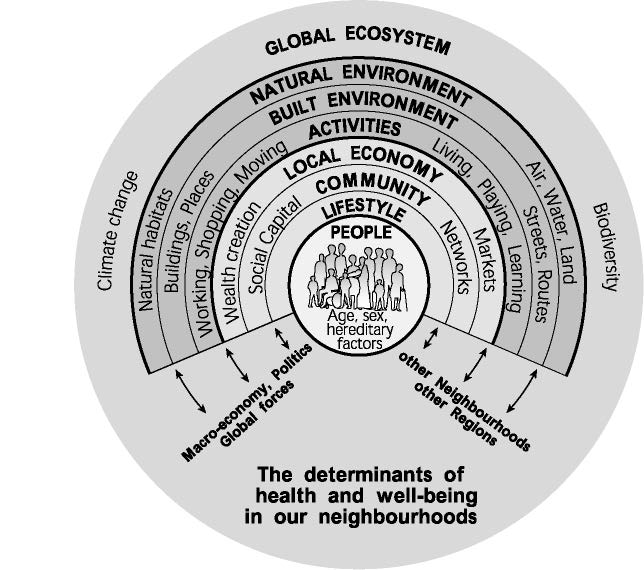Density is a relationship concept. Its meaning changes depending on how we use it. The population density, the dwelling density, the density of uses, and the built density, are among the most commonly used in urban development.
Current global urbanization processes put acute pressure on urban and ecological systems. This has been articulated in UN’s sustainable development goals (SDGs) and in UN-Habitat’s 5 principles for sustainable urban development. High density and compact urban form are thereby often propagated as the solution for more sustainable urbanisation, despite the fact that also a series of negative effects are associated with higher density. UN Habitat (2014) outlines five principles for the development of sustainable neighbourhoods focussing on key characteristics of high density, mixed land use, dense street configurations and social mix.
- Adequate space for streets and an efficient street network. The street network should occupy at least 30 per cent of the land and at least 18 km of street length per km2.
- High density. At least 15,000 people per km2, that is 150 people/ha or 61 people/acre.
- Mixed land-use. At least 40% of floor space should be allocated for economic use in any neighbourhood.
- Social mix. The availability of houses in different price ranges and tenures in any given neighbourhood to accommodate different incomes; 20 to 50 per cent of the residential floor area should be for low-cost housing, and each tenure type should be no more than 50 per cent of the total.
- Limited land-use specialization. This is to limit single-function blocks or neighbourhoods; single function blocks should cover less than 10% of any neighbourhood.
The principles are seeking to promote high-density urban growth, alleviate urban sprawl and maximize land efficiency. The 5 principles are thus expected to achieve the following performances:
- Promote sustainable, diversified, socially equal and thriving communities in economically viable ways.
- Encourage walkable neighbourhoods and reduce car dependency.
- Optimise use of land and provide an interconnected network of streets which facilitate safe, efficient and pleasant walking, cycling and driving.
- Foster local employment, local production and local consumption.
- Provide a variety of lot sizes and housing types to cater for the diverse housing needs of the community, at densities which can ultimately support the provision of local services.
A general consensus has emerged saying that denser and more compact cities also result in more sustainable cities. Higher density development is considered as one of the most important means to counter problems such as climate change and land fragmentation, increase innovation, productivity, job and service accessibility (Ahlfeldt et al 2018), give better accessibility to municipal service opportunities (Jenks et al. 1996) and public transport (Churchman et al 1996). However, there are also negative effects associated with higher density, such as decreased well-being (Chu et al., 2004), more crime (Chhetri et al., 2013), reduced capacity to absorb rainfall and contribute to the urban heat island effect (Carter et al. 2015), decreasing biodiversity (e.g. Hansen et al. 2014), and first indications show reduced mental health related to isolation or crowding (e.g. Barton, Grant 2006, Melis et al 2015, Gruebner et al 2017).
Source: Barton, H. and Grant, M., (2006) A health map for the local human habitat, Journal of the Royal Society for the Promotion of Public Health, 126 (6) pp 252-261
References:
Ahlfeldt,G. and E. Pietrostefani (2018). Demystifying Compact Urban Growth: Evidence from 300 Studies across the World. Working paper OECD. www.coalitionforurbantransitions.org
Barton, Hugh and Grant, Marcus (2006) A health map for the local human habitat. The Journal for the Royal Society for the Promotion of Health, 126 (6). pp. 252-253. ISSN 1466-4240
Carter, Jeremy G., Gina Cavan, Angela Connelly, Simon Guy, John Handley, Aleksandra Kazmierczak (2015). Climate change and the city: Building capacity for urban adaptation, Progress in Planning 95,1–66
Churchman, Arza, Rachelle Alterman, Yael Azmon, Ronit Davidivici-Marton, and Tovi Fenster. 1996. Habitat II: Shadow report. Jerusalem: Israel Women’s Network.
Chu,A., Thorne,A. and Guite,H. (2004). The impact on mental well‐being of the urban and physical environment: an assessment of the evidence. Journal of Mental Health Promotion,3(2).17–32.
Chhetri, P., Han, J.H., Chandra,S. and Corcoran,J. (2013). Mapping urban residential density patterns: Compact city model in Melbourne, Australia. City, Culture and Society, 4(2). 77–85.
Gruebner, O., Rapp, MA., Adli, M., Kluge, U., Galea, S., Heinz, A. (2017) Cities and Mental Health. Deutsches Ärzteblatt International | Dtsch Arztebl Int 2017; 114: 121–7
Hansen,R.and A.Pauleit (2014). From Multifunctionality to Multiple Ecosystem Services? A Conceptual Framework for Multifunctionality in Green Infrastructure Planning for Urban Areas. Ambio, Vol.43, Issue 4, p.516-529
Jenks, M., Burton, E. and Williams, K. (eds) (1996) The Compact City, A Sustainable Urban Form? E & FN Spon, Routledge, London.
UNHabitat(2014).https://unhabitat.org/a‐new‐strategy‐of‐sustainable‐neighbourhood‐planning‐five‐principles/
Further readings on density:
– Berghauser Pont, Haupt (2010) Spacematrix. Space, Density and Urban Form
– Matsumoto, Tadashi; Yoshida, Yasushi; Ostry, Adam; Sanchez-Serra, Daniel et.al. (2012) “Compact City Policies. A Comparative Assessment”, OECD Green growth studies, OECD Publishing. Weblink: http://infoshako.sk.tsukuba.ac.jp/~tj330/Labo/taniguchi/ccity/images/OECD+(2012)+Compact+City+Policies.pdf
– Density Atlas (2011). MIT web resource, http://densityatlas.org/
– Steffen Lehmann (2016) “Sustainable urbanism: towards a framework for quality and optimal density?”, Future Cities and Environment 2:8, DOI 10.1186/s40984-016-0021-3
– Tonkiss, Fran (2013) “Cities by design: the social life of urban form”, Polity Books, London.
– Eberle, Dietmar; Tröger, Eberhard (2014) “Density and Atmosphere: On Factors Relating to Building Density in the European City”, Walter de Gruyter, Berlin.
– Nadja Kabisch, Dagmar Haase (2014) “Green justice or just green? Provision of urban green spaces in Berlin, Germany”, Landscape and Urban Planning, Volume 122, February 2014, p. 129-139.
– Brent D. Ryan (2012) “Design After Decline How America Rebuilds Shrinking Cities”, Univ. Philadephia Press, Philadephia.
– Ricky Burdett; Tony Travers; Darinka Czischke et.al. (2004) “Density and Urban Neighborhoods in London”, LSE Cities, London.




